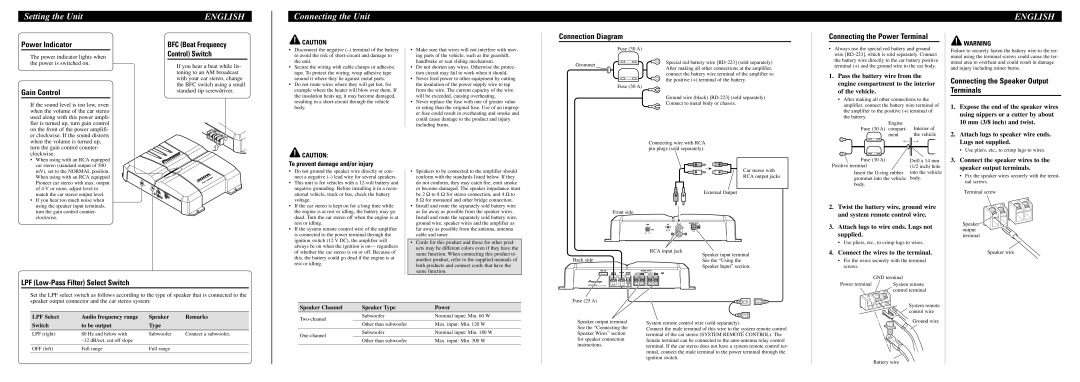GM-3300T specifications
The Pioneer GM-3300T is a robust and versatile two-channel amplifier designed to elevate your car audio experience. Known for its high-quality performance and user-friendly features, the GM-3300T is an excellent choice for both casual listeners and audiophiles alike. With an impressive power output and several sophisticated technologies, this amplifier delivers exceptional sound clarity and depth.One of the standout features of the GM-3300T is its power output capability. This amplifier provides a maximum of 600 watts, allowing it to drive even the most demanding speakers with ease. With a continuous output of 30 watts RMS per channel at 4 ohms, it ensures that your music retains its dynamics without distortion, even at higher volumes. The addition of a variable low-pass filter enables users to customize the sound output based on their specific preferences and the requirements of their audio system.
The GM-3300T also boasts a compact design, making it easy to install in various vehicle types without taking up excessive space. Its heat sink design ensures efficient heat dissipation, promoting long-term reliability and performance without overheating. The amplifier's rugged construction guarantees durability, suitable for the rigors of automotive environments.
In terms of technology, the GM-3300T employs advanced MOSFET power supply technology, enhancing the amplifier's efficiency and responsiveness. This technology allows for better power management, delivering consistent performance across different listening volumes. The amplifier's input can accommodate a range of audio signals, providing versatility for various audio sources, whether it’s a factory-installed head unit or an aftermarket stereo.
Another significant characteristic of the GM-3300T is its user-friendly setup. The amplifier includes adjustable gain controls, making it easy to match the input signal from your head unit. The detachable connector and RCA inputs facilitate straightforward wiring, ensuring a hassle-free installation process.
In summary, the Pioneer GM-3300T stands out in the competitive market of car amplifiers due to its potent power output, advanced technologies, and user-friendly features. It offers exceptional sound quality, making it a fantastic choice for anyone looking to upgrade their vehicle's audio system. Whether you're cruising down the highway or parked at a drive-in, the GM-3300T ensures that your music sounds as it was meant to be heard.

